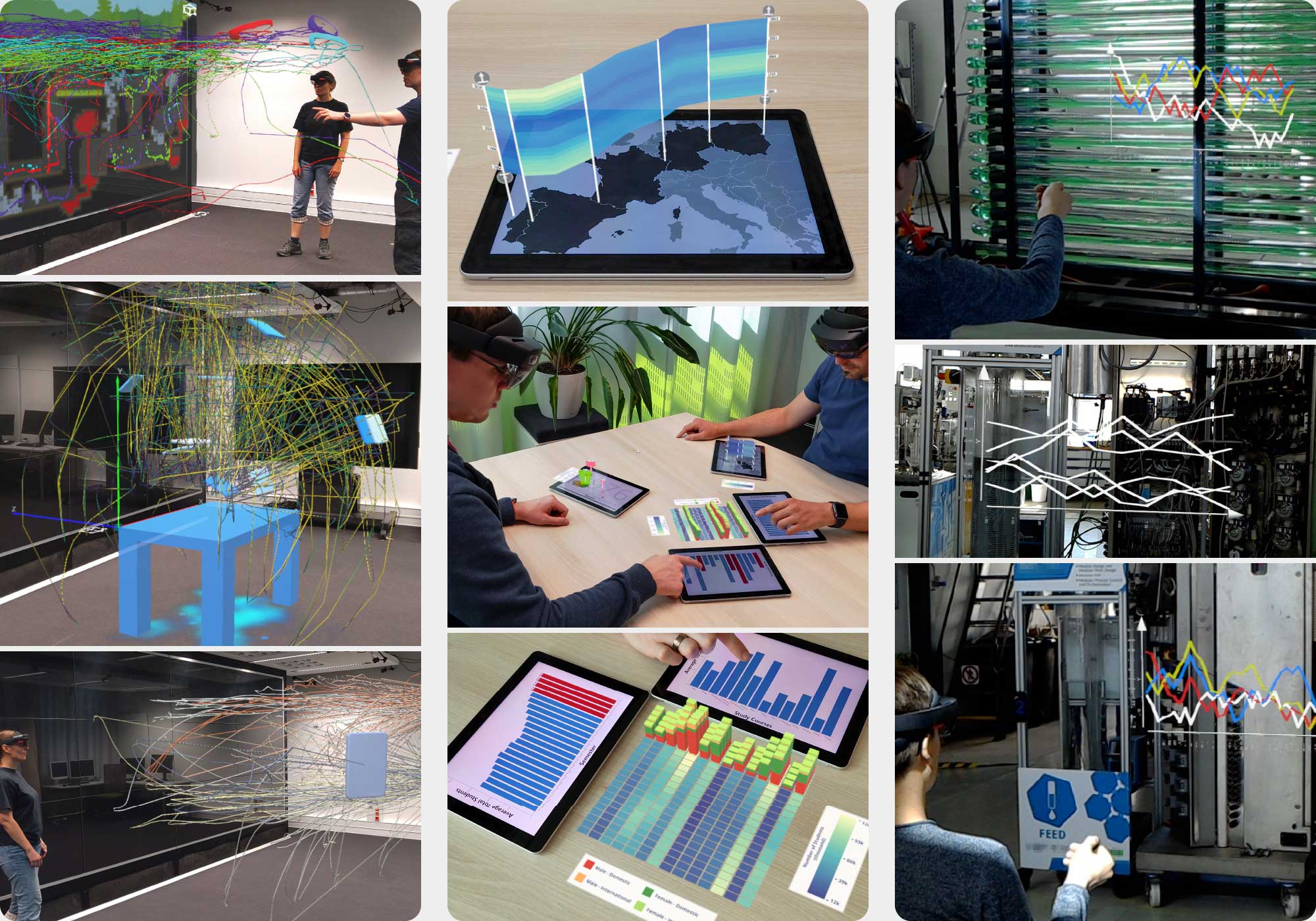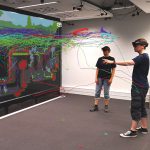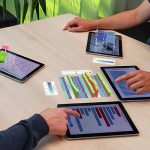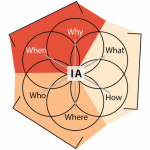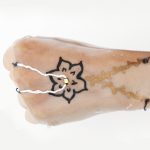We are happy to announce that five full papers with co-authors from our lab have been accepted at ACM CHI 2021!
Three of these papers are projects of our group, with two more papers being co-authored in cooperation with international researchers around the world. We are happy to contribute to the community of the largest and most important conference in the field of human-computer interaction.
All papers will be presented online at the conference May 8-13. Further information, as well as short videos and the already-available author-versions of the papers can be found on their respective project pages.
MIRIA: A Mixed Reality Toolkit for the In-Situ Visualization and Analysis of Spatio-Temporal Interaction Data
With MIRIA, we present a toolkit designed to support the in-situ visual analysis of user interaction in mixed reality and multi-display environments. So far, there are few options to effectively explore and analyze interaction patterns in such novel computing systems. With MIRIA, we address this gap by supporting the analysis of user movement, spatial interaction, and event data by multiple, co-located users directly in the original environment. Based on our own experiences and an analysis of existing approaches, we identify requirements for our system. We report on the design and prototypical implementation of MIRIA, which is informed by these requirements and offers various visualizations such as 3D movement trajectories, position heatmaps, and scatterplots. To demonstrate the value of MIRIA for real-world analysis tasks, we conducted expert feedback sessions using several use cases with authentic study data.
MARVIS: Combining Mobile Devices and Augmented Reality for Visual Data Analysis
With MARVIS, we present a conceptual framework that combines mobile devices and head-mounted Augmented Reality (AR) for visual data analysis. We propose novel concepts and techniques addressing visualization-specific challenges. By showing additional 2D and 3D information around and above displays, we extend their limited screen space. AR views between displays as well as linking and brushing are also supported, making relationships between separated visualizations plausible. We introduce the design process and rationale for our techniques. To validate MARVIS’ concepts and show their versatility and widespread applicability, we describe six implemented example use cases. Finally, we discuss insights from expert hands-on reviews. As a result, we contribute to a better understanding of how the combination of one or more mobile devices with AR can benefit visual data analysis. By exploring this new type of visualization environment, we hope to provide a foundation and inspiration for future mobile data visualizations.
Investigating the Impact of Real-World Environments on the Perception of 2D Visualizations in Augmented Reality
In this work we report on two comprehensive user studies investigating the perception of Augmented Reality (AR) visualizations influenced by real-world backgrounds. Since AR is an emerging technology, it is important to also consider productive use cases, which is why we chose an exemplary and challenging industry 4.0 environment. The experimental production plant was accessible due to the cooperation with the Process-To-Order Lab (see https://tu-dresden.de/ing/forschung/bereichs-labs/P2O-Lab). Our basic perceptual research focuses on both the visual complexity of backgrounds as well as the influence of a secondary task. In contrast to our expectation, data of our 34 study participants indicate that the background has far less influence on the perception of AR visualizations. Moreover, we observed a mismatch between measured and subjectively reported performance. We discuss the importance of the background and recommendations for visual real-world augmentations. Overall, our results suggest that AR can be used in many visually challenging environments without losing the ability to productively work with the visualizations shown.
Additionally, we contributed to two other full papers:
Konstantin Klamka collaborated with the HCI Lab Saarbrücken by co-authoring the paper BodyStylus: Freehand On-Body Design and Fabrication of Epidermal Interface from Narjes Pourjafarian and colleagues.
Furthermore, Grand Challenges in Immersive Analytics, co-authored by Wolfgang Büschel, is a follow-up to last year’s CHI workshop on Future Productivity in Immersive Analytics.
Full Papers at CHI 2021
@inproceedings{fixme,
author = {Wolfgang B\"{u}schel and Anke Lehmann and Raimund Dachselt},
title = {MIRIA: A Mixed Reality Toolkit for the In-Situ Visualization and Analysis of Spatio-Temporal Interaction Data},
booktitle = {Proceedings of the 2021 CHI Conference on Human Factors in Computing Systems},
series = {CHI '21},
year = {2021},
month = {5},
isbn = {978-1-4503-8096-6/21/05},
location = {Yokohama, Japan},
numpages = {15},
doi = {10.1145/3411764.3445651},
publisher = {ACM},
address = {New York, NY, USA},
keywords = {interaction analysis, immersive analytics, in-situ analysis, in-situ visualization, augmented reality, human-computer interaction, visualization}
}List of additional material
@inproceedings{langner:2021:marvis,
author = {Ricardo Langner and Marc Satkowski and Wolfgang B\"{u}schel and Raimund Dachselt},
title = {MARVIS: Combining Mobile Devices and Augmented Reality for Visual Data Analysis},
booktitle = {Proceedings of the 2021 ACM Conference on Human Factors in Computing Systems},
year = {2021},
month = {5},
isbn = {978-1-4503-8096-6/21/05},
location = {Yokohama, Japan},
numpages = {17},
doi = {10.1145/3411764.3445593},
publisher = {ACM},
address = {New York, NY, USA},
keywords = {data visualization, mobile devices, head-mounted augmented reality, cross-device interaction, data analysis, mobile data visualization, augmented displays, immersive analytics}
}List of additional material
@article{satkowski2021investigating,
author = {Marc Satkowski and Raimund Dachselt},
title = {Investigating the Impact of Real-World Environments on the Perception of 2D Visualizations in Augmented Reality},
booktitle = {Proceedings of the 2021 ACM Conference on Human Factors in Computing Systems},
year = {2021},
month = {05},
isbn = {978-1-4503-8096-6/21/05},
location = {Yokohama, Japan},
numpages = {14},
doi = {10.1145/3411764.3445330},
url = {https://doi.org/10.1145/3411764.3445330},
publisher = {ACM},
keywords = {User Study, Augmented Reality, Visual Perception, Immersive Analytics, In-Situ Visualization, AR Visualization, Industrial Scenario, Industry 4.0}
}List of additional material
Pre-Recorded Talk, Video, Teaser, Study Material, Study Data, Statistical Analysis,
@inproceedings{fixme,
author = {Barrett Ens and Benjamin Bach and Maxime Cordeil and Ulrich Engelke and Marcos Serrano and Wesley Willett and Arnaud Prouzeau and Christoph Anthes and Wolfgang B\"{u}schel and Cody Dunne and Tim Dwyer and Jens Grubert and Jason H. Haga and Nurit Kirshenbaum and Dylan Kobayashi and Tica Lin and Monsurat Olaosebikan and Fabian Pointecker and David Saffo and Nazmus Saquib and Dieter Schmalstieg and Danielle Albers Szafir and Matthew Whitlock and Yalong Yang},
title = {Grand Challenges in Immersive Analytics},
booktitle = {Proceedings of the 2021 CHI Conference on Human Factors in Computing Systems},
series = {CHI '21},
year = {2021},
month = {05},
isbn = {978-1-4503-8096-6/21/05},
location = {Yokohama, Japan},
numpages = {17},
doi = {10.1145/3411764.3446866},
publisher = {ACM},
address = {New York, NY, USA}
}List of additional material
@inproceedings{Pourjafarian2021,
author = {Narjes Pourjafarian and Marion Koelle and Bruno Fruchard and Sahar Mavali and Konstantin Klamka and Daniel Groeger and Paul Strohmeier and J\"{u}rgen Steimle},
title = {BodyStylus: Freehand On-Body Design and Fabrication of Epidermal Interfaces},
booktitle = {Proceedings of the 2021 ACM Conference on Human Factors in Computing Systems},
year = {2021},
month = {5},
isbn = {978-1-4503-8096-6/21/05},
location = {Yokohama, Japan},
numpages = {15},
doi = {10.1145/3411764.3445475},
publisher = {ACM},
address = {New York, NY, USA}
}List of additional material

